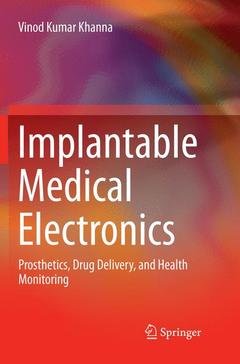Description
Implantable Medical Electronics, 1st ed. 2016
Prosthetics, Drug Delivery, and Health Monitoring
Author: Khanna Vinod Kumar
Language: English
Subjects for Implantable Medical Electronics:
Publication date: 03-2019
453 p. · 15.5x23.5 cm · Paperback
Publication date: 12-2015
Support: Print on demand
Description
/li>Biography
/li>Comment
/li>
- The insertion of an implantable neural amplifier for accurate recording of neural signals for neuroengineering studies
- The use of implantable pulse generators for pacing the activities of diseased organs
- The use of implantable sensors for observing the influence of therapy and monitoring a patient?s biological parameters
- The use of drug delivery systems to supervise the supply of accurate doses of medicine to affected parts
Reviews cutting-edge technology and applications in the field of implantable medical devices, including therapeutic nanoparticulate drug delivery, implantable sensors as monitoring tools, and manufacturing technologies for implants
Broadens reader understanding of regulatory standards and fabrication technologies in the field of implantable medical electronics
Includes case studies that illustrate active health monitoring and drug delivery systems




